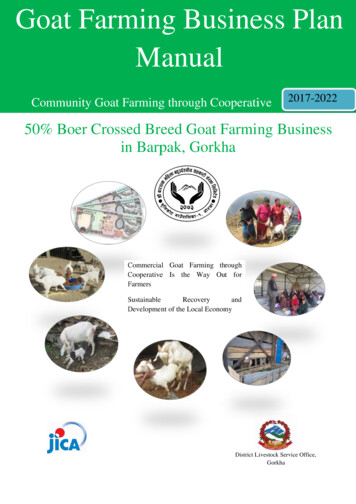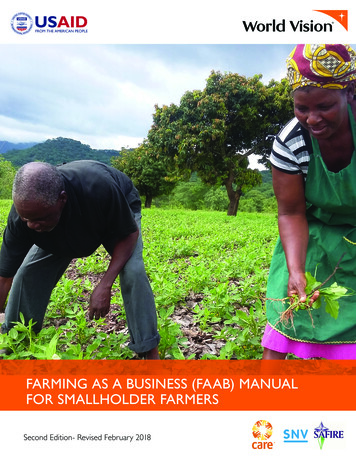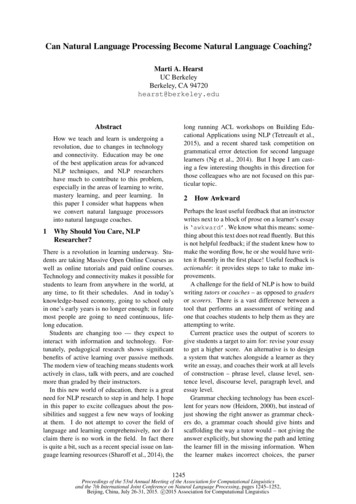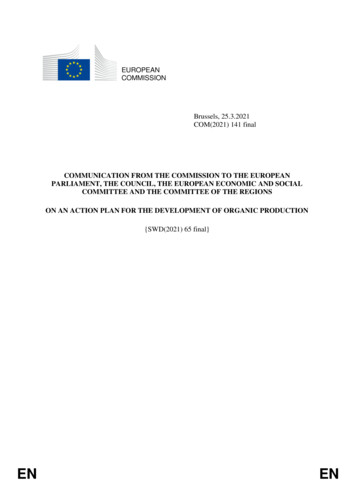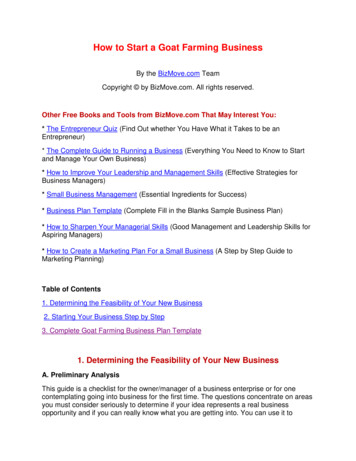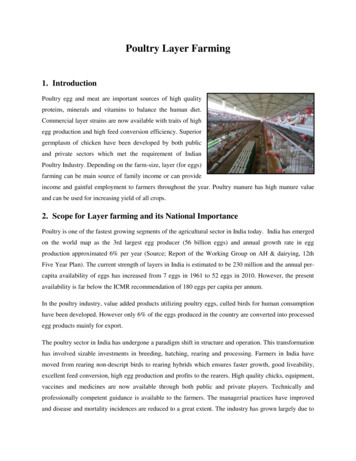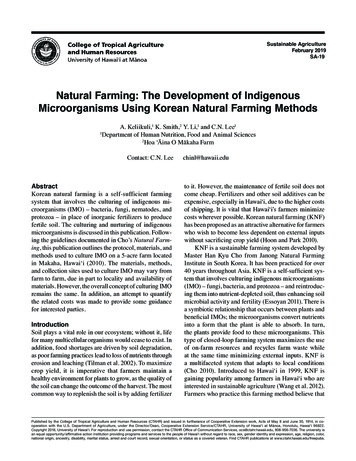
Transcription
Sustainable AgricultureFebruary 2019SA-19Natural Farming: The Development of IndigenousMicroorganisms Using Korean Natural Farming MethodsA. Keliikuli,1 K. Smith,2 Y. Li,1 and C.N. Lee1Department of Human Nutrition, Food and Animal Sciences2Hoa ‘Āina O Mākaha Farm1Contact: C.N. LeeAbstractKorean natural farming is a self-sufficient farmingsystem that involves the culturing of indigenous microorganisms (IMO) – bacteria, fungi, nematodes, andprotozoa – in place of inorganic fertilizers to producefertile soil. The culturing and nurturing of indigenousmicroorganisms is discussed in this publication. Following the guidelines documented in Cho’s Natural Farming, this publication outlines the protocol, materials, andmethods used to culture IMO on a 5-acre farm locatedin Makaha, Hawai‘i (2010). The materials, methods,and collection sites used to culture IMO may vary fromfarm to farm, due in part to locality and availability ofmaterials. However, the overall concept of culturing IMOremains the same. In addition, an attempt to quantifythe related costs was made to provide some guidancefor interested parties.IntroductionSoil plays a vital role in our ecosystem; without it, lifefor many multicellular organisms would cease to exist. Inaddition, food shortages are driven by soil degradation,as poor farming practices lead to loss of nutrients througherosion and leaching (Tilman et al. 2002). To maximizecrop yield, it is imperative that farmers maintain ahealthy environment for plants to grow, as the quality ofthe soil can change the outcome of the harvest. The mostcommon way to replenish the soil is by adding fertilizerchinl@hawaii.eduto it. However, the maintenance of fertile soil does notcome cheap. Fertilizers and other soil additives can beexpensive, especially in Hawai‘i, due to the higher costsof shipping. It is vital that Hawai‘i’s farmers minimizecosts wherever possible. Korean natural farming (KNF)has been proposed as an attractive alternative for farmerswho wish to become less dependent on external inputswithout sacrificing crop yield (Hoon and Park 2010).KNF is a sustainable farming system developed byMaster Han Kyu Cho from Janong Natural FarmingInstitute in South Korea. It has been practiced for over40 years throughout Asia. KNF is a self-sufficient system that involves culturing indigenous microorganisms(IMO) – fungi, bacteria, and protozoa – and reintroducing them into nutrient-depleted soil, thus enhancing soilmicrobial activity and fertility (Essoyan 2011). There isa symbiotic relationship that occurs between plants andbeneficial IMOs; the microorganisms convert nutrientsinto a form that the plant is able to absorb. In turn,the plants provide food to these microorganisms. Thistype of closed-loop farming system maximizes the useof on-farm resources and recycles farm waste whileat the same time minimizing external inputs. KNF isa multifaceted system that adapts to local conditions(Cho 2010). Introduced to Hawai‘i in 1999, KNF isgaining popularity among farmers in Hawai‘i who areinterested in sustainable agriculture (Wang et al. 2012).Farmers who practice this farming method believe thatPublished by the College of Tropical Agriculture and Human Resources (CTAHR) and issued in furtherance of Cooperative Extension work, Acts of May 8 and June 30, 1914, in cooperation with the U.S. Department of Agriculture, under the Director/Dean, Cooperative Extension Service/CTAHR, University of Hawai‘i at Mānoa, Honolulu, Hawai‘i 96822.Copyright 2018, University of Hawai‘i. For reproduction and use permission, contact the CTAHR Office of Communication Services, ocs@ctahr.hawaii.edu, 808-956-7036. The university isan equal opportunity/affirmative action institution providing programs and services to the people of Hawai‘i without regard to race, sex, gender identity and expression, age, religion, color,national origin, ancestry, disability, marital status, arrest and court record, sexual orientation, or status as a covered veteran. Find CTAHR publications at www.ctahr.hawaii.edu/freepubs.
UH–CTAHRKorean Natural Farming: Development of Indigenous Microoganismsit minimizes their dependence on inorganic fertilizersand pesticides. However, little scientific documentationof the benefits of these practices exists as yet (Park andDuponte 2010).ObjectivesThe objectives for this study were to a) identify some ofthe resources readily available on a farm site that canbe used for the development of IMO, b) demonstrate thechronological development of IMO, and c) provide someestimates of cost and time for the process of developingIMO. This publication outlines the steps used to collectIMO from a farm in Makaha, Hawai‘i. For a detailedguide on how to collect and cultivate indigenous microorganisms using traditional methods, refer to Cho’s bookNatural Farming (2010).SA-19 — Feb. 2019Materials and MethodsKNF involves a four-step process of capturing, cultivating, and preserving indigenous microorganisms (IMO).These four steps create products that are often referredto as IMO 1, IMO 2, IMO 3, and IMO 4. As previouslymentioned, the process of collecting and culturing microorganisms may vary farm to farm due to localityand availability of materials and supplies. However, theprinciple remains the same. The following materials wereused for the collection and culturing of IMOs. 0.3 x 0.3 x 0.15m (1 x 1 x 0.5 ft.) lauhala box withcover (a cedar box, plastic container, or ceramicbowl are alternatives) 340 g (2 cups) of steamed white rice (preferably onthe dry side) 20L bucket with holes drilled on the sides (refer toTable 1. Natural inputs used to make the IMO (Cho 2010)CharacteristicsAmount added per 22.68kg of wheat mill runLactic AcidBacteriaAbundant in the whey from yogurt and cheese-making, or can be cultivated with rice wash water (saved from the first rinse of rice in preparationfor cooking) and unpasteurized milk.30 mlOriental HerbalNutrientLicorice, angelica, ginger, garlic, and cinnamon are the ingredients used inthe preparation of OHN.30 mlFermentedPlant JuiceFPJ is made by taking the growing tips of healthy plants—vegetables,herbs, or weeds, mixing them with brown sugar, and allowing them to ferment.30 mlFish Amino AcidA liquid made from fish waste. Similar to Asian fish sauce used in foodpreparation, but without the added salt, it is made by mixing fish parts withbrown sugar and letting the mixture ferment for a few months.15 mlWater-SolubleCalciumMade from roasted eggshells soaked in BRV (brown rice vinegar).15 mlSeawaterDiluted with fresh water; used to add minerals, for soil treatment beforeseeding, and to enhance ripening of fruit.1LBiocharHighly porous charcoal. Provides a storehouse for all the nutrients andmicrobes.10L bucketIMO Inputs2
UH–CTAHR Korean Natural Farming: Development of Indigenous MicrooganismsSA-19 — Feb. 2019Figure 1b and 1c)Small mixing containerLarge (4L) glass jarTwineSemipermeable material (paper towel, cloth, canvas)Brown sugar (570 g)22.68 kg bag of wheat mill runShovelMixing container20L of fishpond waterMeasuring spoon (15 ml; 1 tablespoon)Natural inputs (refer to Table 1)Making IMO 1 – Collecting IMOThe first step to making IMO is to locate an area tocollect the microbes. The preferred site to collect IMOis near the rhizosphere of plants whose roots containsugar. According to Master Cho and other Koreannatural farmers, plants in the Bambusoideae (bamboo)family are the ideal choice, as their roots contain a highamount of sugar (Cho and Cho 2010). These sugars attractbacterial-dominated microbes and nematodes. In addition to bamboo, broadleaf trees and leaf molds are othercommonly used sites (Cho and Cho 2010). Three specificsites on the farm were selected to collect microbes: near1) bamboo plant, 2) Artocarpus altilis (breadfruit tree),and 3) Leucaena leucocephala (haole koa tree). Hence,three separate batches of IMO were made by utilizingthree different collection sites. The following procedureoutlines the collection and cultivation of microbes frombamboo (Figure 1a).The lauhala box was filled 1/3 full with hard-cookedrice (use less water to cut back on the amount of moisture). The main goal here is to provide the microbeswith a food source. The lauhala cover was placed backonto the box. This allows the microbes to enter while atthe same time keeping leaf litter and insects out. Thecontainer was then placed close to the root system ofthe bamboo (Figure 1b) and covered with leaf litter anda bucket containing holes. This acts as a second lineof defense to keep animals and excessive amounts ofrainwater out. The container was left undisturbed forfive days (Cho 2010).After five days had passed, the container was removed from the site (Figure 1c). A successful collectionof microbes presents a white, cloudy covering of mi-Figure 1a. Collection site (bamboo tree)Figure 1b. Rice (covered with a bucket) placed close torhizosphere of a bamboo treeFigure 1c. Removing lauhala basket (containing rice) fromcollection site 5 days later3
UH–CTAHRKorean Natural Farming: Development of Indigenous MicrooganismsSA-19 — Feb. 2019Figure 2a. Presence of white mycelium on the surface isrepresentation of a successful collection of microbes.Figure 2b. Presence of a green layer covering the ricerepresents an unsuccessful collection of microbes.Figure 3a. IMO 1Figure 3b. Brown sugar added to IMO 1Figure 3c. Mixing the contents4Figure 3d. Mix for 5 minutes or until homogenous.Figure 3 e . Mix tureplaced in glass jarcovered with a pieceof mesh fabric
UH–CTAHRKorean Natural Farming: Development of Indigenous Microoganismscrobes, with little to no presence of red and blue molds(Figure 2a). However, if the rice is covered entirely witha green layer (Figure 2b), anaerobic microbes have accumulated (Cho 2010). If this happens, discard the contentsand repeat the process.SA-19 — Feb. 20193d). A piece of canvas was placed over the opening andsecured with twine. The jar was placed in a cool, shadedarea out of direct sunlight for seven days. The productof this process is called foundation stock, or more commonly IMO 2.Making IMO 3 – Multiplying the IMOMaterials and tools needed to make IMO 3 include 22.68kg of wheat mill run (or a carbohydrate source), 20L offishpond water, a 20L bucket, natural inputs/nutrientliquids (refer to Table 1), a measuring spoon, and 15ml of IMO 2. The wheat mill run was placed in a largecontainer (i.e., wheelbarrow, large bucket, tractor dumpbucket, etc.) under a cool, shaded area (Figure 4a). 15 mlof IMO 2 was added to 20L of fishpond water, and themixture was stirred thoroughly (Figure 4b). The inputsfrom Table 1 were added to this mixture.The contents within the bucketwere poured onto the wheat millrun and mixed thoroughly (Figure 4c). The moisture level of thismixture should be between 65 and75% (Reddy 2011). Soil moisturewas determined using the “feel andappearance method” (Klocke andFischbach 1998). The wheat millrun mixture was then placed directlyonto the soil (35.0–40.0 cm high) ina partially shaded area (70% shadeand 30% light). It was then coveredwith leaves and allowed to sit forFigure 4b. Natural inputs mixed intoeight days (Figure 4d).20L of fishpond waterAs the mixture (IMO 3) ferments, the core temperature of thepile increases. To prevent the microbes that are present within/nearthe core from dying of the high temperatures, the heat must be evenlydistributed throughout the pile.Thus, the pile was turned over everytwo days to bring down the temperature and to mix the microbes. Visibility of white fungi (mycorrhizae)covering the top layer of the IMO isa sign of successful inoculation. AtFigure 4d. Wheat mill run placedthe end of this process, IMO 3 willonto the soil and covered with leaveshave formed into clumps (Figure 5a).held in place with rocks.Making IMO 2 – Cultivation of IMOThis step involves the cultivation of IMO. Materialsneeded for this process included a small mixing container, jar (i.e., glass, ceramic, or clay), porous material(i.e., paper towel, Korean paper, or cloth), a piece oftwine, and brown sugar. The inoculated rice obtainedfrom the previous process (IMO 1) was placed into acontainer (Figure 3a), along with 570 g (1:1 ratio) ofbrown sugar (Figure 3b). The contents were then mixedfor approximately five minutes (Figure 3c). Once homogenized, the mixture was placed into a jar (FigureFigure 4a. Wheat mill run (50 lbs.)placed into tractor dump bucketFigure 4c. Pond water mixture addedto wheat mill run and mixed till homogenous.5
UH–CTAHRKorean Natural Farming: Development of Indigenous MicrooganismsMaking IMO 4 – Inoculating the SoilMaking IMO 4 is the final step. Materials needed forthis process include IMO 3, a large bucket, soil fromthe farm, and biochar. In a bucket, break up the IMO 3(entire inoculated pile of wheat mill run) so that thereare no large pieces (Figure 5b). Mix in 10L of biochar(Figure 5c). Next, pour the contents out of the bucket andmix with soil in a 1:1 ratio. The fermentation process issimilar to that of IMO 3 (moisture 65–70%, 35.0–40.0cm high, temperature 40–50 C). The pile was thencovered with leaf litter and allowed to sit for another 5days. IMO is much more effective when inoculated tothe soil (Cho 2010). The end product of this process isreferred to as IMO 4.Application of IMO 4The final product, IMO 4, should be used as a topdressing. Gently mix 150 kg/0.1 ha (minimum) into thetopsoil. For optimal results, cover the inoculated soilwith mulch (i.e., bamboo leaf litter, wood chips, etc.).Adding mulch is very effective, as it retains moisture,keeps weeds at bay, and also provides the microbes withprotection from direct sunlight. It is recommended thatIMO 4 be applied to the soil seven days before seedingor transplanting and two to three hours prior to sunset(Cho 2010). Treating the soil in the late afternoon givesthe microbes more time to adjust to the environmentalchanges, particularly the increase in temperature.DiscussionThis experiment was designed to cultivate IMO usingthe equipment and materials available on the farm. TheSA-19 — Feb. 2019lauhala basket used to make IMO 1 was made with leavesfrom the hala tree located on the property. The traditionalmethod recommends the use of a cedar box. However,any type of container, including a plastic container orceramic bowl, etc., will do. In regards to cultivating IMO1, never attempt to collect IMO during rainy seasons, astoo much moisture promotes the growth of pathogenicmicrobes (Cho 2010). Additionally, the time it takes tocultivate IMO 1 is highly dependent on the weather. Thecollection process takes 4–5 days in cool weather ( 20 C) or 3–5 days under warmer ( 20 C) conditions (Parkand DuPonte 2010).In reference to the propagation of IMO 3, 22.68 kgof wheat mill run was used as a carbohydrate source forthe microbes. As an alternative, macadamia nut shells(preferably ground), spent grains from breweries, woodchips, rice bran, ulu, or kalo skins may be used in placeof wheat mill run. The type of nutrient inputs added isentirely dependent on availability. However, no studieshave been done to compare the efficacy of the source ofcarbohydrates used. Natural inputs are important, as theyenhance plant growth and IMO proliferation. Eventually,the nutrients in the soil will diminish. When that occurs,more nutrients will need to be added to the soil in orderfor both plants and microbes to flourish. KNF relies onthe use of bio-organic fertilizers such as calcium fromegg shells, nitrogen from fish waste, or potassium fromthe tips of healthy leaves (fermented plant juice). Forthis study, a nutrient analysis was not performed on eachof the inputs used in the production of IMO. However,Maghirang (2011) provided an approximate analysis ofsome of the natural inputs used to make IMO (Table 2).Figure 5a. IMO 3 clumps into aggre- Figure 5b. IMO 3 broken into smaller Figure 5c. Biochar added to IMO 3clumpsgates6
UH–CTAHRKorean Natural Farming: Development of Indigenous MicrooganismsWhether farmers are subsistence or commercial,they take into account a number of factors, such as selfsufficiency, labor intensity, and cost, when selecting afarming method that best suits their needs. Korean natural farming is a great alternative for farmers looking tobecome self-sufficient and less dependent on externalinputs such as inorganic pesticides and fertilizers. KNFis environmentally friendly in that it creates a smallercarbon footprint as compared to conventional farmingmethods. In some cases, farmers are able to obtainall the materials and equipment needed to cultivateIMO directly from their farms or source them locally.Synthetic fertilizers on the other hand, such as Gaviota 16-16-16 (distributed by BEI Hawaii), are importedto the Hawaiian Islands (http://www.beihawaii.com/company info.html). However, these inorganic fertilizers require no preparation and can be applied to thesoil at any time. In contrast, IMO need to be cultivatedbefore application; hence, additional labor is requiredto make them.Not including the length of time needed to preparenatural inputs, it takes approximately 25 days to makeIMO 1 through IMO 4 (Table 3). Repeating the processtakes roughly 11–15 days. The 340 g of rice and 570g of brown sugar used in this experiment made wellSA-19 — Feb. 2019over 700 ml of IMO 2. Only 15 ml of IMO 2 was usedper batch of IMO 3. Any unused portion of IMO 2 canbe stored between 1 and 15 C and reused at a laterday (Cho 2010). The jar should remain well ventilated(semi-permeable lid/cover) and be monitored over timefor the presence of bubbles in the medium, which meanthe microbial population is declining.The overall cost associated with the cultivation andpropagation of IMO is quite comparable to the cost ofinorganic fertilizers (Table 4). All the materials andequipment needed for this experiment were found onsite except for three items: Calrose rice, C&H goldenbrown sugar, and 22.68 kg of wheat mill run ( 41.76,Paakea Feed and Farm). The calculations showed thatit costs roughly 44.31 to make 45 kg of IMO 4. Atan application rate of 150 kg/0.1 ha (150 g/m2), IMO 4costs 0.14/m2 for the initial batch and only 0.13/m 2thereafter (using the foundation stock, IMO 2). In comparison, a 9 kg bag of Gaviota 16-16-16 costs 23.82.At a recommended application rate of 49g/m2, it costs 0.13/m2. The cost difference between the two is veryminute. However, this estimated cost does not take intoaccount the additional three hours of labor required tomake IMO. Finding a cheaper alternative carbohydratesource could substantially reduce the overall cost.Table 2. Proximate Analysis of Fermented Inputs (Maghirang 2011)Fermented FruitJuiceFermented PlantJuiceFish Amino AcidsOriental Herbal NutrientNitrogen (N)429.47855.061166.34405.16Phosphorus (P)61.87122.72193.4474.84Potassium (K)120173934.2314.6522.3Calcium (Ca)307.23913.03377.92181.03Magnesium (Mg)119.55333.6480.58111.58Sodium (Na)51.15128.19426.478.58Iron (Fe)15.0752.2419.7387.19Copper (Cu)0.750.870.940.81Manganese (Mn)2.194.541.454.13Zinc (Zn)1.973.745.842.04Nutrient (mg/kg)7
UH–CTAHRSA-19 — Feb. 2019Korean Natural Farming: Development of Indigenous MicrooganismsTable 3. Ingredients and Timeline for Developing Indigenous Micro-organisms (IMO) (Maghirang 2011)InputCulturing/Propagation Period (Days)IngredientsInitial ProcessAdditional Process(Using IMO 2 Foundation Stock)4–5n/a7n/aIMO 1- 340 g of riceIMO 2*- 570 g brown sugarIMO 3- 22.68 kg of wheat mill run- 20L of pond water- Natural inputs*- 15 ml of IMO #27–107–10IMO 4- 10L bucket of biochar4–54–522–2611–15Total preparation time* IMO 2 foundation stock can be stored (1–15 C) for future use* Natural inputs added include lactic acid bacteria, oriental herbal nutrient, fruitplant juice, fermented fruit juice, fish amino acid, and water-soluble calciumTable 4 Cost breakdown between IMO and inorganic fertilizerCosts Comparison Between IMO and Conventional Fertilizer (Inorganic)IngredientCost per WholeUnit PurchasedAmount Usedfor 1 BatchAdjusted CostApplicationRateCost per m2IMO6.8 kg bag of Calrose rice 11.16340 g 0.56C & H golden brown sugar 907 g 3.19570 g 1.990.15 kg/m222.68 kg bag of wheat mill run 41.76Amount of IMO made per batchTotal cost22.68 kg 41.76 45 kg 56.11 44.31 0.13*– 0.14Inorganic FertilizerGaviota 16-16-16 9.07 kg 23.82n/an/a0.05 kg/m2*It costs 0.14/m2 to make the 1st batch, then 0.13/m2 thereafter (using the IMO 2 foundation stock)8 0.13
UH–CTAHRKorean Natural Farming: Development of Indigenous MicrooganismsIn conclusion, the cultivation and propagation ofIMO may be somewhat labor intensive. The cost is analogous to synthetic fertilizers available on the market, whenlabor cost is excluded. The cost to make IMO 4 can besignificantly reduced if all the materials and equipmentneeded to cultivate and propagate IMO can be sourceddirectly on the farm.AcknowledgementsThe authors would like to thank the owner and operators of the nonprofit organization Hoa ‘Aina O Mākaha,who allowed us to perform the experiment at the site.This research was partially funded by the College ofTropical Agriculture and Human Resources via theUSDA-HATCH and Smith Level funds (Integratedproject, year 2014).ReferencesCho, H.-K., and J.-Y. Cho. 2010. Natural Farming. HanKyu Cho. CGNF. Seoul, South Korea.Cho, J.-Y. 2010. Natural Farming; Agricultural Materials. Han-Kyu Cho. CGNF. Seoul, S. Korea. www.janonglove.comEssoyan, Susan. 2011. Natural selection: A self-sufficientsystem of farming is increasing yields across Hawaii.SA-19 — Feb. 2019Star-Advertiser. Retrieved October 1, 2017: http://www.staradvertiser.com/news/20110118 Natural selection.html?id 114074644Klocke, Norman L., and P.E. Fischbach. 1998. Estimating Soil Moisture by Appearance and Feel, Publication G84-690-A, Nebraska Cooperative ExtensionService.Maghirang, Rodel G. 2011. Organic Fertilizers fromFarm Waste Adopted by Farmers in the Philippines.Institute of Plant Breeding-Crop Science Cluster.Retrieved January 10, 2017: http://www.fftc.agnet.org/library.php?func view&id 20110804162833Reddy, Rohini. 2011. Cho’s Global Natural Farming. Retrieved April 10, 2016: lobal-natural-farming-sarra.pdfWang, Koon-Hui, DuPonte M, and Chang K. 2012. Useof Korean Natural Farming for Vegetable CropProduction in Hawai‘i. Hanai’Ai/The Food Provider.Retrieved April 1, 2017; s/V14-Wang-KNF.pdfTilman, David, Cassman G., Matson P., Naylor R., andPolasky S. 2002. A review article: Agriculturesustainability and intensive production practices.Nature, 418, 671–677. DOI:10.1038/nautre010149
Natural Farm-ing, this publication outlines the protocol, materials, and methods used to culture IMO on a 5-acre farm located in Makaha, Hawai‘i (2010). The materials, methods, and collection sites used to culture IMO may vary from farm to farm, due in part to locality and availability of
